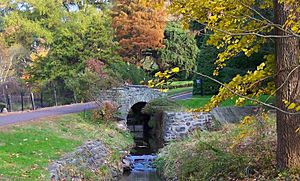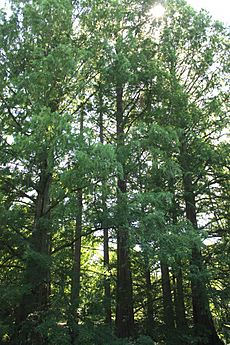Morris Arboretum facts for kids
Quick facts for kids Morris Arboretum |
|
|---|---|

A bridge at the Morris Arboretum
|
|
| Lua error in Module:Location_map at line 420: attempt to index field 'wikibase' (a nil value). | |
| Type | Arboretum |
| Location | 100 East Northwestern Avenue, Philadelphia and Whitemarsh Township, Pennsylvania |
| Area | 92 acres (37 ha) |
| Operated by | University of Pennsylvania |
|
Compton and Bloomfield
|
|
| Area | 175 acres (71 ha) |
| Built | 1889 |
| Architect | Theophilus Parsons Chandler, Jr.; Wilson Eyre, Jr., et al. |
| Architectural style | Classical Revival, Late Gothic Revival |
| NRHP reference No. | 78002445 |
| Added to NRHP | December 22, 1978 |
The Morris Arboretum of the University of Pennsylvania is a special place where you can explore many different kinds of plants. It covers 92 acres (about 37 hectares) and is the official arboretum for the state of Pennsylvania. An arboretum is like a living museum for trees and other plants.
You can visit the Arboretum every day, except on major holidays. Just remember to get your tickets online before you go. The last time you can enter is at 3 PM. You'll find this amazing garden at 100 East Northwestern Avenue in Chestnut Hill, Philadelphia, Pennsylvania.
Contents
History of the Arboretum
The Morris Arboretum used to be the private home of a brother and sister, John T. Morris and Lydia T. Morris. They bought the land and started designing the gardens in 1887.
John Morris loved growing plants from all over the world. He even planted trees that were collected in China around 1900 by a famous plant explorer named E. H. Wilson. Many of the old trees you see today were planted by the Morris family!
After Lydia Morris passed away in 1932, the estate became a public arboretum in 1933. This meant everyone could come and enjoy the beautiful plants and gardens.
Amazing Plant Collections

Today, the Morris Arboretum has over 13,000 different plants! These plants belong to more than 2,500 types. They come from places with mild climates, like North America, Asia, and Europe. The arboretum especially focuses on plants from Asia.
You can find many interesting groups of plants here. Some popular collections include native azaleas, tall conifers (like pine trees), shiny hollies, beautiful magnolias, colorful maples, fragrant roses, and unique witch hazels.
The arboretum is proud of 17 very special trees in its collection. These include the amazing Metasequoia glyptostroboides, also known as the dawn redwood. This tree was once thought to be extinct, but it was rediscovered! Other notable trees are different kinds of firs, maples, buckeyes, cedars, beeches, pines, plane trees, oaks, hemlocks, and elms.
Cool Features to Explore
The Morris Arboretum is designed like a beautiful English park, but it also has some Japanese garden styles. You'll find winding paths, gentle streams, a peaceful swan pond, and colorful gardens filled with roses, rhododendrons, and magnolias.
Here are some of the cool things you can see and do:
- Dawn Redwoods: These are special trees that were once thought to be gone forever, but they were found again!
- English Park: This area was designed around 1912. It has many plants collected from China, including different kinds of maples, witch hazels, dogwoods, cherries, and stuartias.
- Fernery: Built in 1899, this is a unique 8-sided glass house. It's believed to be the only free-standing Victorian fernery left in North America. Inside, you'll see rocks, waterfalls, and a goldfish pond, along with hundreds of different ferns.
- Garden Railway: Get ready for tiny trains and trolley cars! These G-scale models run on tracks and show different types of railroads from history.
- Hillcrest Pavilion: This is a handy spot with restrooms, drinking fountains, and Picnic Benches if you need a break.
- Japanese Overlook: This spot mixes English and Japanese garden styles. It has special stones, stone lanterns, and beautiful Japanese maples.
- Japanese Hill and Water Garden: Created in 1905, this garden has hills, rocks, water, trees, bridges, paths, and lanterns, all designed in a traditional Japanese style.
- Key Fountain: A decorative fountain shaped like a key, found in the English Park.
- Log Cabin: A rustic log cabin with a working hand-operated water pump.
- Mercury Loggia and Ravine Garden: This area features a classical building with a sculpture of "Mercury at rest." Below it is a pretty rock garden in a valley.
- Oak Alee: Enjoy a walk down this path lined with tall oak trees on both sides.
- Out on a Limb: This is a metal walkway that lets you get a close-up view of the trees, almost like you're walking among their branches!
- Pennock Garden: An exotic flower garden with a large rectangular fountain.
- Rose Garden: Planted in 1888, this garden has four sections of roses with a fountain in the middle, all edged with buxus plants.
- Rock Wall Garden: See many different alpine plants growing on a six-foot-high wall.
- Swan Pond: A peaceful small lake created in 1905, where you might spot swans.
- Sculpture Garden: Discover various art sculptures placed throughout the garden.
- Step Fountain: A unique fountain shaped like a staircase in the English Park.
- Visitor Center & Gift Shop: Here you'll find restrooms, drinking fountains, and a seasonal cafe. You can also buy souvenirs.
The Morris Arboretum also owns Springfield Mill, which is across from the main entrance. This old grist mill has been fixed up and is open once a month for demonstrations where you can see how grain was ground into flour!
Images for kids


